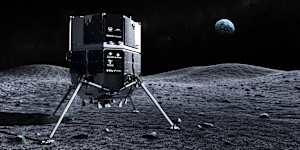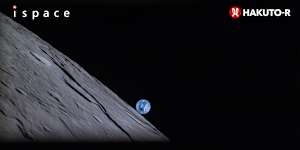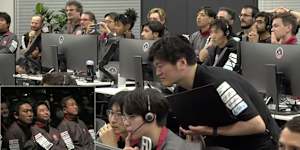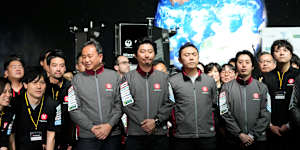Final pings of data in the moments before the planned touchdown showed the lander’s speed rapidly increasing,leading engineers at mission control in Tokyo to determine a successful landing was “not achievable”,ispace said in a statement.
“We lost the communication,so we have to assume that we could not complete the landing on the lunar surface,” the company’s founder chief executive Takeshi Hakamada said on a livestream,shortly after communication from the spacecraft ceased.

This illustration provided by ispace this month depicts the Hakuto spacecraft on the surface of the moon.ispace
Success would have been a welcome change from recent setbacks Japan has faced in space technology,where it aims to build a domestic industry,including a goal of sending its astronauts to the moon by the late 2020s.
But a lunar landing would be. Only the United States,the former Soviet Union and China have soft-landed spacecraft on the moon,with attempts in recent years by India and a private Israeli company ending in failure.
The Japanese firm “determined that there is a high probability that the lander eventually made a hard landing”.

The lunar Earthrise during solar eclipse,captured by the lander-mounted camera at an altitude of about 100 km from the lunar surface.ispace
In disclosure to the Tokyo Stock Exchange,ispace said it did not expect an immediate impact on its earnings forecast. The startup delivers payloads such as rovers to the moon and sells related data. It does not expect to book any profit until around 2025.
Four months after launching from Cape Canaveral,Florida,on a SpaceX rocket in December,the M1 lander appeared set to autonomously touch down about 2.40am AEST on Wednesday after coming as close as 90 metres from the lunar surface,a live animation of the lander’s telemetry showed.
At the expected touchdown time,engineers in mission control appeared anxious as they awaited signal confirmation of M1’s fate,but no such confirmation came.
“Our engineers will continue to investigate the situation,” Hakamada said at the time. “At this moment,what I can tell is we are very proud of the fact that we have already achieved many things during this Mission 1.”
The spacecraft completed eight out of 10 mission objectives in space that would provide valuable data for the next landing attempt in 2024,Hakamada said. That Mission 2 spacecraft is already under construction.

Flight controllers in Tokyo wait for a signal from the company’s Hakuto spacecraft after a landing attempt on the surface of the moon.ispace via AP
A successful landing would have marked a welcome reversal from recent setbacks Japan has faced in space technology,where it has big ambitions of building a domestic industry,including a goal of sending Japanese astronauts to the moon by the late 2020s.
Roughly an hour before the planned touchdown,the 2.3-metre-tall M1 began its landing phase,gradually tightening its orbit around the moon from 100 kilometres above the surface to roughly 25 kilometres,travelling at nearly 6000 km/h.
The company’s chief technology officer Ryo Ujiie,speaking to reporters earlier,likened the task of slowing the lander to the correct speed against the moon’s gravitational pull to “stepping on the brakes on a running bicycle at the edge of a ski jumping hill”.

Takeshi Hakamada,centre,founder and chief executive of ispace and his team.AP
The lander was expected to reach a landing site at the edge of Mare Frigoris,in the moon’s northern hemisphere,where it would have deployed a two-wheeled,baseball-sized rover developed by the Japan Aerospace Exploration Agency (JAXA),toymaker Tomy Co and Sony Group. It also planned to deploy a four-wheeled “Rashid” rover from the United Arab Emirates.
The M1 also carried an experimental solid-state battery made by Niterra Co,among other objects to gauge how they perform on the moon.
Reuters
Get a note direct from our foreigncorrespondentson what’s making headlines around the world..